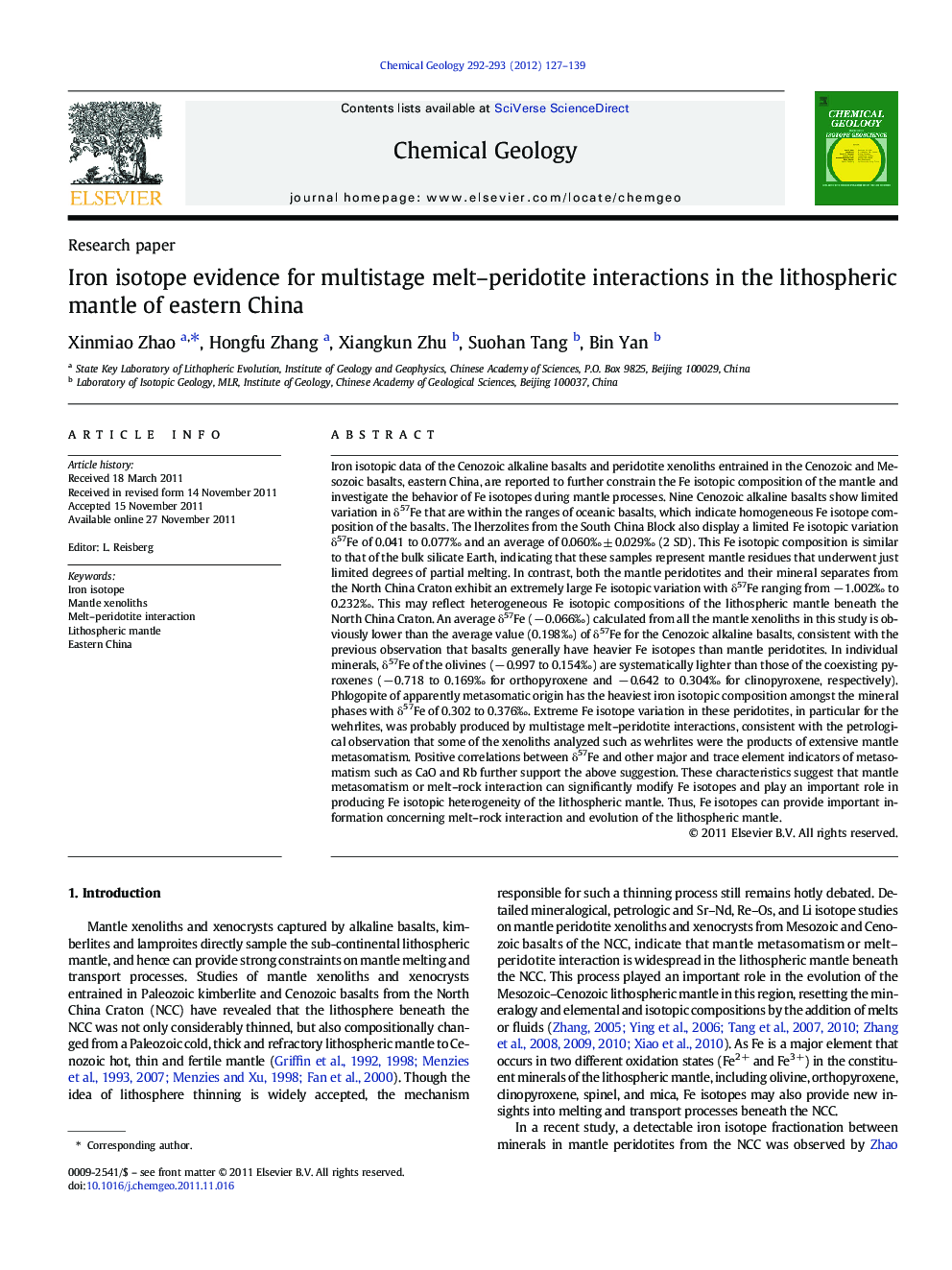| کد مقاله | کد نشریه | سال انتشار | مقاله انگلیسی | نسخه تمام متن |
|---|---|---|---|---|
| 4699558 | 1637654 | 2012 | 13 صفحه PDF | دانلود رایگان |

Iron isotopic data of the Cenozoic alkaline basalts and peridotite xenoliths entrained in the Cenozoic and Mesozoic basalts, eastern China, are reported to further constrain the Fe isotopic composition of the mantle and investigate the behavior of Fe isotopes during mantle processes. Nine Cenozoic alkaline basalts show limited variation in δ57Fe that are within the ranges of oceanic basalts, which indicate homogeneous Fe isotope composition of the basalts. The lherzolites from the South China Block also display a limited Fe isotopic variation δ57Fe of 0.041 to 0.077‰ and an average of 0.060‰ ± 0.029‰ (2 SD). This Fe isotopic composition is similar to that of the bulk silicate Earth, indicating that these samples represent mantle residues that underwent just limited degrees of partial melting. In contrast, both the mantle peridotites and their mineral separates from the North China Craton exhibit an extremely large Fe isotopic variation with δ57Fe ranging from − 1.002‰ to 0.232‰. This may reflect heterogeneous Fe isotopic compositions of the lithospheric mantle beneath the North China Craton. An average δ57Fe (− 0.066‰) calculated from all the mantle xenoliths in this study is obviously lower than the average value (0.198‰) of δ57Fe for the Cenozoic alkaline basalts, consistent with the previous observation that basalts generally have heavier Fe isotopes than mantle peridotites. In individual minerals, δ57Fe of the olivines (− 0.997 to 0.154‰) are systematically lighter than those of the coexisting pyroxenes (− 0.718 to 0.169‰ for orthopyroxene and − 0.642 to 0.304‰ for clinopyroxene, respectively). Phlogopite of apparently metasomatic origin has the heaviest iron isotopic composition amongst the mineral phases with δ57Fe of 0.302 to 0.376‰. Extreme Fe isotope variation in these peridotites, in particular for the wehrlites, was probably produced by multistage melt–peridotite interactions, consistent with the petrological observation that some of the xenoliths analyzed such as wehrlites were the products of extensive mantle metasomatism. Positive correlations between δ57Fe and other major and trace element indicators of metasomatism such as CaO and Rb further support the above suggestion. These characteristics suggest that mantle metasomatism or melt–rock interaction can significantly modify Fe isotopes and play an important role in producing Fe isotopic heterogeneity of the lithospheric mantle. Thus, Fe isotopes can provide important information concerning melt–rock interaction and evolution of the lithospheric mantle.
► Fe isotope ratios of basalts and mantle xenoliths from eastern China were measured.
► Cenozoic alkaline basalts show a limited variation in Fe isotopic composition.
► Mantle xenoliths and their mineral separates exhibit an extremely large Fe isotopic variation.
► Positive correlations between δ57Fe and CaO and Rb suggest that melt–rock interaction can significantly modify Fe isotopes.
► Fe isotopes can provide important information concerning the melt–rock interaction.
Journal: Chemical Geology - Volumes 292–293, 23 January 2012, Pages 127–139